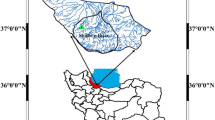Abstract
Hydrological processes forecasting is an essential step for better water management and sustainability. Among several hydrological processes, lake water level (LWL) forecasting is one of the significant processes within a particular catchment. The complexity of the LWL fluctuation is owing to the diversity of the influential parameters including climate, hydrology and some other morphology. In this study, several versions of neurocomputing intelligence models are developed for LWL fluctuation forecasting at five great lakes Lake Superior, Lake Michigan, Lake Huron, Lake Erie, and Lake Ontario, located at the north of USA. The applied models are including M5-Tree, multivariate adaptive regression spline (MARS) and least square support vector regression (LSSVR). The models are developed using several input combinations that are configured based on the correlated lags in addition to the periodicity of time series. The sequential influence of the lakes order is considered in the modeling development. Also, cross-station modeling where lag time series of upstream lakes are used to forecast downstream LWL. Results are assessed using several statistical metrics and graphical visualization. Overall, the results indicated that the applied forecasting models efficient and trustworthy. The component of the periodicity time series enhances the forecasting performance. Cross-station modeling revealed an optimistic modeling strategy for learning transfer modeling of using information of nearby site.








Similar content being viewed by others
Data and materials availability
Data will be provided with final accepted version.
References
Li XY, Xu HY, Sun YL et al (2007) Lake-level change and water balance analysis at lake Qinghai, West China during recent decades. Water Resour Manag 21:1505–1516. https://doi.org/10.1007/s11269-006-9096-1
Tong SL, Cui CF, Bai YL et al (2016) Application of multivariate adaptive regression spline models in long term prediction of river water pollution. Taiwan Water Conserv. https://doi.org/10.1016/j.jhydrol.2015.12.014
Armanuos A, Ahmed K, Shiru MS, Jamei M (2021) Impact of increasing pumping discharge on groundwater level in the nile delta aquifer. Egypt Knowledge-Based Eng Sci 2:13–23
Caplan B, Covitt B, Love G et al (2021) Using computational thinking and modeling to build water and watershed literacy. Connect Sci Learn, 3
Kelts K, Talbot M (1990) Lacustrine carbonates as geochemical archives of environmental change and biotic/abiotic interactions. In: Tilzer MM, Serruya C (eds) Large lakes. Springer, Berlin, Heidelberg, pp 288–315
Lücke A, Schleser GH, Zolitschka B, Negendank JFW (2003) A Lateglacial and Holocene organic carbon isotope record of lacustrine palaeoproductivity and climatic change derived from varved lake sediments of Lake Holzmaar, Germany. Quat Sci Rev 22:569–580
Ehteram M, Ferdowsi A, Faramarzpour M et al (2021) Hybridization of artificial intelligence models with nature inspired optimization algorithms for lake water level prediction and uncertainty analysis. Alexandria Eng J 60:2193–2208
Şen Z, Kadioğlu M, Batur E (2000) Stochastic Modeling of the Van Lake Monthly Level Fluctuations in Turkey. Theor Appl Climatol 65:99–110. https://doi.org/10.1007/s007040050007
Demir V (2022) Enhancing monthly lake levels forecasting using heuristic regression techniques with periodicity data component: application of Lake Michigan. Theor Appl Climatol. https://doi.org/10.1007/s00704-022-03982-0
Schulz S, Darehshouri S, Hassanzadeh E et al (2020) Climate change or irrigated agriculture–what drives the water level decline of Lake Urmia. Sci Rep 10:1–10s
Bengtsson L, Malm J (1997) Using rainfall-runoff modeling to interpret lake level data. J Paleolimnol 18:235–248
Zhu S, Lu H, Ptak M et al (2020) Lake water-level fluctuation forecasting using machine learning models: a systematic review. Environ Sci Pollut Res 27:44807–44819
Khan MS, Coulibaly P (2006) Application of Support Vector Machine in Lake Water Level Prediction. J Hydrol Eng. https://doi.org/10.1061/(asce)1084-0699(2006)11:3(199)
Altunkaynak A (2007) Forecasting surface water level fluctuations of lake van by artificial neural networks. Water Resour Manag 21:399–408. https://doi.org/10.1007/s11269-006-9022-6
Altunkaynak A, Sen Z (2007) Fuzzy logic model of lake water level fluctuations in Lake Van, Turkey. Theor Appl Climatol 90:227–233
Karimi S, Shiri J, Kisi O, Makarynskyy O (2012) Forecasting water level fluctuations of urmieh lake using gene expression programming and adaptive neuro-fuzzy inference system. Int J Ocean Clim Syst. https://doi.org/10.1260/1759-3131.3.2.109
Buyukyildiz M, Tezel G, Yilmaz V (2014) Estimation of the change in lake water level by artificial intelligence methods. Water Resour Manag 28:4747–4763. https://doi.org/10.1007/s11269-014-0773-1
Shafaei M, Kisi O (2016) Lake level forecasting using wavelet-SVR, wavelet-ANFIS and wavelet-ARMA conjunction models. Water Resour Manag 30:79–97. https://doi.org/10.1007/s11269-015-1147-z
Hrnjica B, Bonacci O (2019) Lake level prediction using feed forward and recurrent neural networks. Water Resour Manag. https://doi.org/10.1007/s11269-019-02255-2
Bonakdari H, Ebtehaj I, Samui P, Gharabaghi B (2019) Lake water-level fluctuations forecasting using minimax probability machine regression, relevance vector machine, gaussian process regression, and extreme learning machine. Water Resour Manag. https://doi.org/10.1007/s11269-019-02346-0
Wang Q, Wang S (2020) Machine learning-based water level prediction in lake erie. Water (Switzerland). https://doi.org/10.3390/w12102654
Fan C, Song C, Liu K et al (2021) Century-scale reconstruction of water storage changes of the largest lake in the inner mongolia plateau using a machine learning approach. Water Resour Res. https://doi.org/10.1029/2020WR028831
Yaseen ZM, Kisi O, Demir V (2016) Enhancing long-term streamflow forecasting and predicting using periodicity data component: application of artificial intelligence. Water Resour Manag 30:4125–4151. https://doi.org/10.1007/s11269-016-1408-5
Sattari MT, Sureh FS, Kahya E (2020) Monthly precipitation assessments in association with atmospheric circulation indices by using tree-based models. Nat Hazards 102:1077–1094
Deo RC, Samui P, Kim D (2016) Estimation of monthly evaporative loss using relevance vector machine, extreme learning machine and multivariate adaptive regression spline models. Stoch Environ Res risk Assess 30:1769–1784
Yaseen ZM, Ali M, Sharafati A et al (2021) Forecasting standardized precipitation index using data intelligence models: regional investigation of Bangladesh. Sci Rep. https://doi.org/10.1038/s41598-021-82977-9
Zahiri J, Mollaee Z, Ansari MR (2020) Estimation of suspended sediment concentration by M5 model tree based on hydrological and moderate resolution imaging spectroradiometer (MODIS) data. Water Resour Manag 34:3725–3737
Bahmani R, Solgi A, Ouarda TBMJ (2020) Groundwater level simulation using gene expression programming and M5 model tree combined with wavelet transform. Hydrol Sci J 65:1430–1442. https://doi.org/10.1080/02626667.2020.1749762
Naganna SR, Beyaztas BH, Bokde N, Armanuos AM (2020) On the evaluation of the gradient tree boosting model for groundwater level forecasting. Knowledge-Based Eng Sci 1:48–57
Annin P (2018) The Great Lakes Water Wars. Island Press/Center for Resource Economics, Washington, DC
Vaccaro L, Read J (2011) Vital to Our Nation’s economy: Great lakes jobs 2011 report. 7
Coulibaly P (2010) Reservoir computing approach to great lakes water level forecasting. J Hydrol 381:76–88. https://doi.org/10.1016/j.jhydrol.2009.11.027
Quinlan JR (1992) Learning with continuous classes. Mach Learn 92:343–348
Mitchell TM (1997) Machine Learning. McGraw-hill, New York
Solomatine DP, Xue Y (2004) M5 model trees and neural networks: application to flood forecasting in the upper reach of the huai river in China. J Hydrol Eng 9:491–501. https://doi.org/10.1061/(ASCE)1084-0699(2004)9:6(491)
Pal M, Deswal S (2009) M5 model tree based modelling of reference evapotranspiration. Hydrol Process. https://doi.org/10.1002/hyp.7266
Friedman JH (1991) Multivariate adaptive regression splines. Ann Stat 19:1–67. https://doi.org/10.1214/aos/1176347963
De Andrés J, Lorca P, de Cos Juez FJ, Sánchez-Lasheras F (2011) Bankruptcy forecasting: a hybrid approach using fuzzy c-means clustering and multivariate adaptive regression splines (MARS). Expert Syst Appl 38:1866–1875
Sharda VN, Patel RM, Prasher SO et al (2006) Modeling runoff from middle Himalayan watersheds employing artificial intelligence techniques. Agric Water Manag 83:233–242. https://doi.org/10.1016/j.agwat.2006.01.003
Demir V, Çubukçu EA (2021) Digital elevation modeling with heuristic regression techniques abstract. Eur J Sci Technol. https://doi.org/10.31590/ejosat.916012
Bera P, Prasher SO, Patel RM et al (2006) Application of MARS in simulating pesticide concentrations in soil. Trans ASABE 49:297–307. https://doi.org/10.13031/2013.20228
Sephton P (2001) Forecasting recessions: can we do better on MARS? Review, vol. 83, pp.39–49
Al-Sudani ZA, Salih SQ, Sharafati A, Yaseen ZM (2019) Development of multivariate adaptive regression spline integrated with differential evolution model for streamflow simulation. J Hydrol 573:1–12. https://doi.org/10.1016/j.jhydrol.2019.03.004
. Suykens JAK, Vandewalle J (1999) No Title. Neural Process Lett 9:293–300. Doi: https://doi.org/10.1023/A:1018628609742
URL1 (2022) LSSVR. http://www.esat.kuleuven.be/sista/lssvmlab/
URL2 MARS and M5Tree
URL3 Taylor Diagram
URL4 (2022) Boxblot & Violin plot
Tiyasha TTM, Yaseen ZM (2020) A survey on river water quality modelling using artificial intelligence models: 2000–2020. J Hydrol 585:124670. https://doi.org/10.1016/j.jhydrol.2020.124670
Yaseen ZM (2021) An insight into machine learning models era in simulating soil, water bodies and adsorption heavy metals: Review, challenges and solutions. Chemosphere 277:130126. https://doi.org/10.1016/j.chemosphere.2021.130126
Legates DR, McCabe GJ (1999) Evaluating the use of “goodness-of-fit” measures in hydrologic and hydroclimatic model validation. Water Resour Res 35:233–241. https://doi.org/10.1029/1998WR900018
Tur R, Yontem S (2021) A Comparison of Soft Computing Methods for the Prediction of Wave Height Parameters. Knowledge-Based Eng Sci 2:31–46
Aoulmi Y, Marouf N, Amireche M et al (2021) Highly Accurate Prediction Model for Daily Runoff in Semi-Arid Basin Exploiting Metaheuristic Learning Algorithms. IEEE Access 9:92500–92515. https://doi.org/10.1109/ACCESS.2021.3092074
Taylor KE (2001) Summarizing multiple aspects of model performance in a single diagram. J Geophys Res Atmos 106:7183–7192. https://doi.org/10.1029/2000JD900719
Sharafati A, Khosravi K, Khosravinia P et al (2019) The potential of novel data mining models for global solar radiation prediction. Int J Environ Sci Technol. https://doi.org/10.1007/s13762-019-02344-0
Hintze JL, Nelson RD (1998) Violin Plots: A Box Plot-Density Trace Synergism Statistical Computing and Graphics Violin Plots: A Box Plot-Density Trace Synergism. Source Am Stat 52:181–184
Legouhy A (2021) al_goodplot - boxblot & violin plot. In: MATLAB Cent. mathworks
Ebtehaj I, Bonakdari H, Gharabaghi B (2019) A reliable linear method for modeling lake level fluctuations. J Hydrol. https://doi.org/10.1016/j.jhydrol.2019.01.010
Yaseen ZM, Mohtar WHMW, Ameen AMS et al (2019) Implementation of univariate paradigm for streamflow simulation using hybrid data-driven model: Case study in tropical region. IEEE Access 7:74471–74481
Adnan RM, Liang Z, Heddam S et al (2020) Least square support vector machine and multivariate adaptive regression splines for streamflow prediction in mountainous basin using hydro-meteorological data as inputs. J Hydrol 586:124371. https://doi.org/10.1016/j.jhydrol.2019.124371
Hadi SJ, Abba SI, Sammen SSH et al (2019) Non-linear input variable selection approach integrated with non-tuned data intelligence model for streamflow pattern simulation. 1–16
Sudheer KP, Gosain AK, Ramasastri KS (2002) A data-driven algorithm for constructing artificial neural network rainfall-runoff models. Hydrol Process 16:1325–1330. https://doi.org/10.1002/hyp.554
Bhagat SK, Tung TM, Yaseen ZM (2020) Heavy metal contamination prediction using ensemble model: Case study of Bay sedimentation. Australia J Hazard Mater 403:123492. https://doi.org/10.1016/j.jhazmat.2020.123492
Sanikhani H, Kisi O, Maroufpoor E, Yaseen ZM (2018) Temperature-based modeling of reference evapotranspiration using several artificial intelligence models: application of different modeling scenarios. Theor Appl Climatol, Doi: https://doi.org/10.1007/s00704-018-2390-z
Beyaztas U, Salih SQ, Chau K-W et al (2019) Construction of functional data analysis modeling strategy for global solar radiation prediction: application of cross-station paradigm. Eng Appl Comput Fluid Mech 13:1165–1181
Oleiwi S, Jalal S, Hamed S et al (2018) Precipitation pattern modeling using cross-station perception: regional investigation. Environ Earth Sci. https://doi.org/10.1007/s12665-018-7898-0
Acknowledgements
The authors would like to thank the support received from KTO Karatay University.
Funding
The research received no funds.
Author information
Authors and Affiliations
Contributions
Vahdettin Demir: Conceptualization; validation; investigation; data curation; methodology; project leader; editing; formal analysis; visualization; writing. Zaher Mundher Yaseen: Supervision; validation; investigation; editing, conceptualization; writing.
Corresponding author
Ethics declarations
Conflict of interest
The authors declare no conflict of interest to any party.
Ethical approval
The manuscript is conducted within the ethical manner advised by the targeted journal.
Consent to participate
Not applicable.
Consent to publish
The research is scientifically consent to be published.
Additional information
Publisher's Note
Springer Nature remains neutral with regard to jurisdictional claims in published maps and institutional affiliations.
Appendices
Appendix 1
See Table 9.
Appendix 2
See Table 10.
Appendix 3
See Table 11.
Appendix 4
See Table 12.
Appendix 5
See Table 13.
.
Appendix 6a
See Fig. 8.
Appendix 6b
See Fig. 9.
Appendix 6c
See Fig. 10.
Appendix 6d
See Fig. 11.
Appendix 6e
See Fig. 12.
Appendix 7a
See Fig. 13.
Appendix 7b
See Fig. 14.
Appendix 7c
See Fig. 15.
Appendix 7d
See Fig. 16.
Appendix 7e
See Fig. 17.
Appendix 8
See Table 14.
Appendix 9
See Table 15.
Rights and permissions
Springer Nature or its licensor holds exclusive rights to this article under a publishing agreement with the author(s) or other rightsholder(s); author self-archiving of the accepted manuscript version of this article is solely governed by the terms of such publishing agreement and applicable law.
About this article
Cite this article
Demir, V., Yaseen, Z.M. Neurocomputing intelligence models for lakes water level forecasting: a comprehensive review. Neural Comput & Applic 35, 303–343 (2023). https://doi.org/10.1007/s00521-022-07699-z
Received:
Accepted:
Published:
Issue Date:
DOI: https://doi.org/10.1007/s00521-022-07699-z














